From ohitashi salad to miso ramen toppings and wafu pasta additions, Japanese have mastered spinach in countless ways and goma-ae might be the easiest.
The secret is to blanch it just right so it stays bright and crunchy, and serve it coated with a tasty sesame sauce. Ready to win dinnertime?
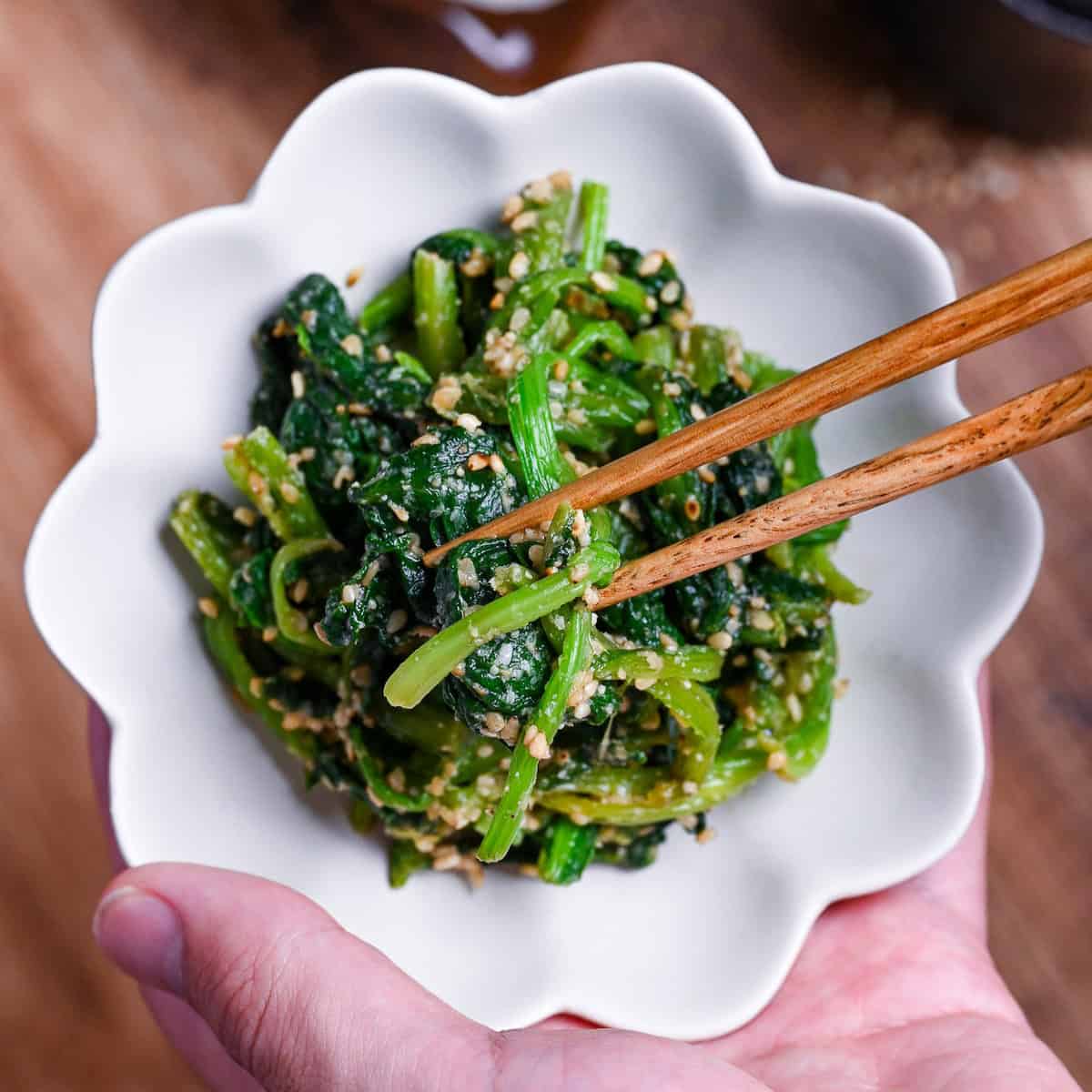
Gomaae Salad
Recipe Snapshot
- What is it? A classic Japanese spinach side dish with sweet, nutty sesame dressing.
- Flavor profile: Nutty, Savory, Delicate
- Why you’ll love this recipe: The nutty sesame dressing transforms plain spinach into something genuinely crave-worthy.
- Must-haves: Spinach, Ground sesame seeds, Japanese soy sauce.
- Skill Level: Easy
- Suitable for Meal Prep? Yes, this goma-ae is excellent for meal prep.
Summarize & Save this content on:
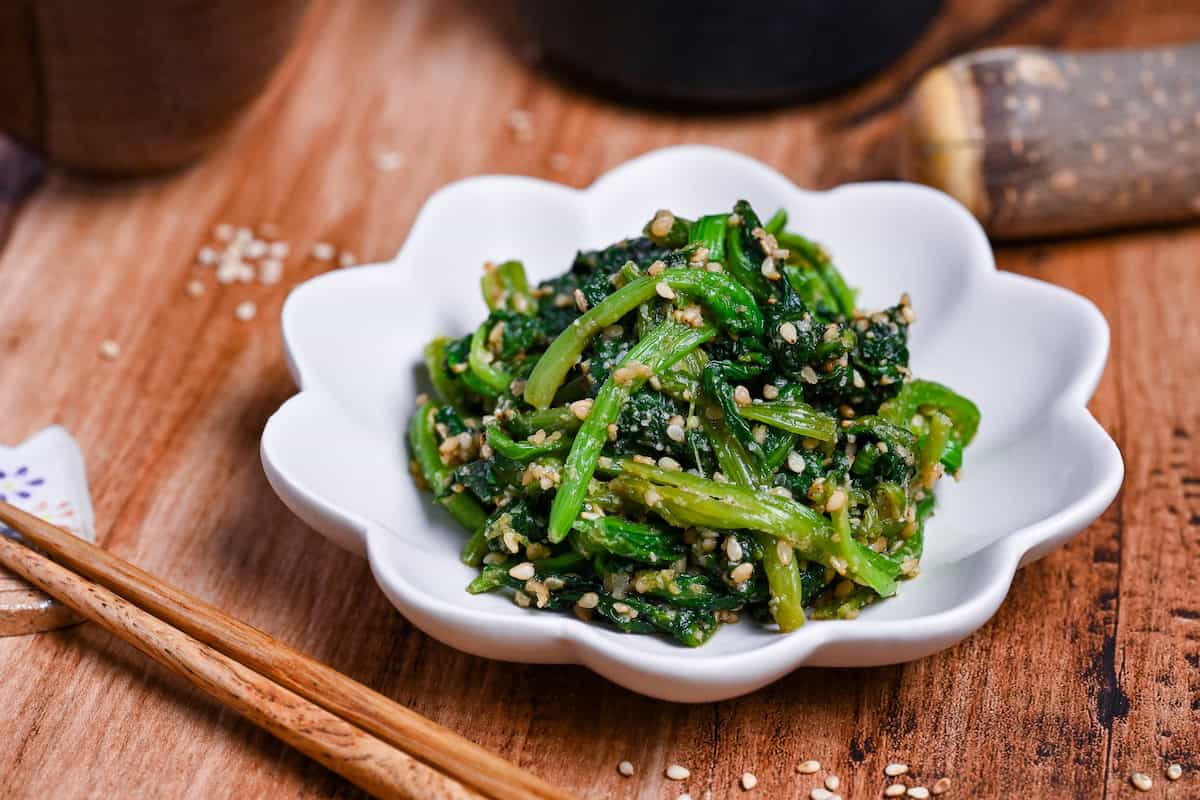
What is Horenso no Gomaae?
Spinach with Sesame Dressing, or Goma-ae, is one of the classic Japanese side dishes where blanched greens are tossed in a nutty-sweet sesame sauce. The dressing is made by grinding sesame seeds and seasoning them with soy sauce (shoyu) and sugar.
It’s one of those go-to sides you’ll find in bento boxes, weeknight dinners, and potlucks because it’s simple and easy to prepare ahead of time. Pair it with a comforting bowl of authentic miso soup, freshly cooked Japanese rice, and you’ve got the kind of balanced Japanese-inspired meal that feels both nourishing and doable on a busy weeknight.
Gomaae Salad Ingredients
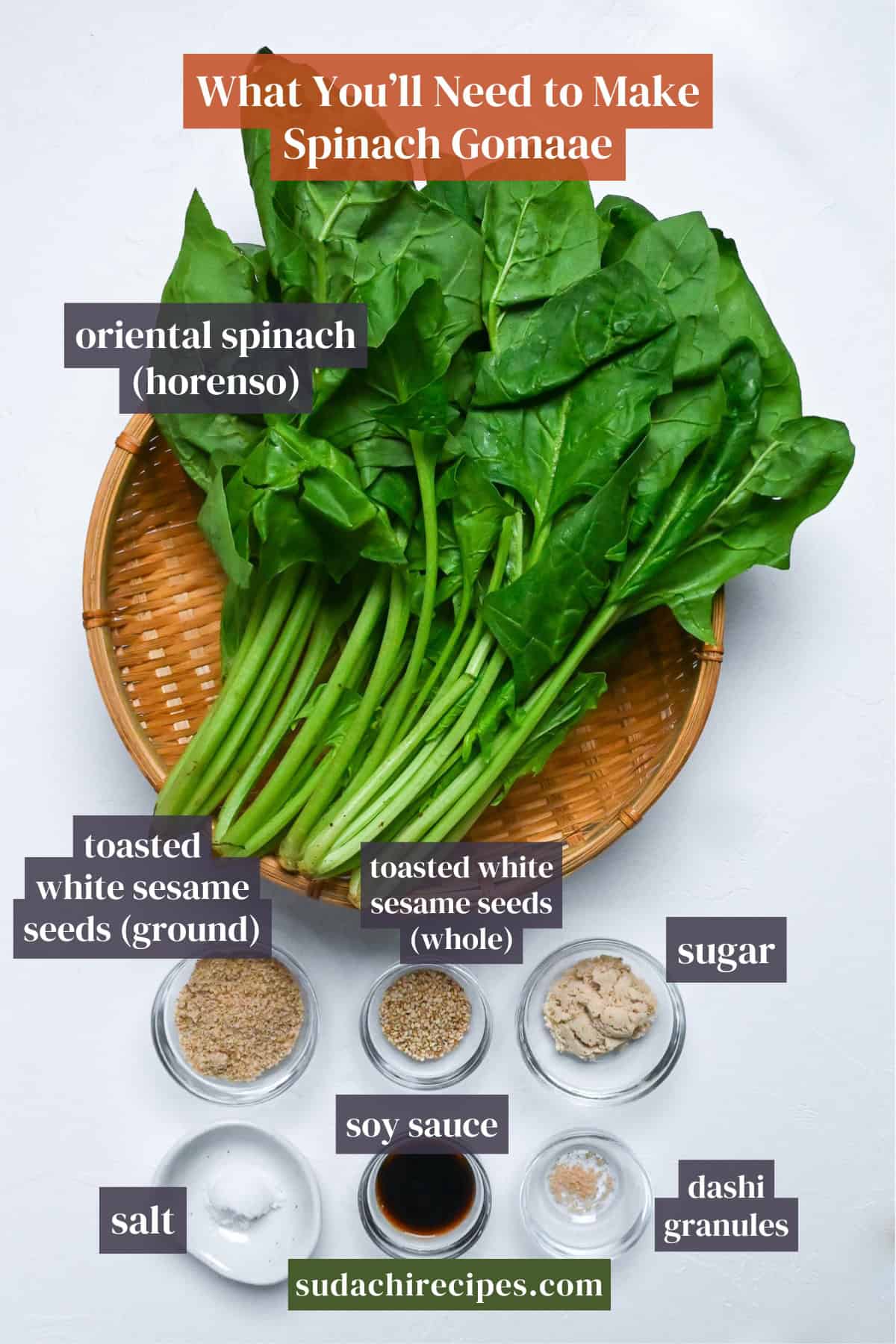
- Oriental spinach (horenso): You’ll find bunched spinach with roots (horenso-style). If bunched spinach isn’t handy, use baby spinach (blanch just a flash) or swap in other greens.
- Ground sesame seeds: This is toasted white sesame ground to a sandy, fragrant crumble that releases a warm, nutty aroma in sauces. Look for pre-ground “suri goma” at Japanese/Asian markets or online. Whole roasted seeds are widely stocked if you want to grind them yourself in a spice grinder or suribachi.
- Dashi granules: I chose granules over making fresh dashi because weeknight dinners need to be realistic. You can grab it at Asian groceries and, increasingly, in mainstream chains’ international aisles or online. For a fish-free route, choose kombu-based dashi powder.
Substitution Ideas
- Frozen spinach: Thaw completely and squeeze out every drop of water to to avoid watery goma-ae. The texture will be softer, but the sesame dressing covers any textural differences.
- Other sturdy greens: Swiss chard and beet greens work beautifully here, giving you that same hearty bite with a slightly earthy flavor that pairs perfectly with sesame. Both need the same blanching treatment as spinach. Save chard stems for another dish, or blanch them an extra minute before adding the leaves.
- Beyond leafy greens: This sesame dressing transforms any blanched vegetable! Green beans, broccoli, bean sprouts, or asparagus all work. Just adjust blanching time for each vegetable. Whatever texture you get during blanching is your final result.
One of my YouTube subscribers told me that this dish worked well with Swiss chard, cime di rapa and even puntarelle for her.
Have trouble finding Japanese ingredients? Check out my ultimate guide to Japanese ingredient substitutes!
How to Make My Spinach Gomaae
Before you start: Split the root ends lengthwise and fan them open with your fingers. Swish the bunch vigorously in a bowl of cold water to dislodge grit, lift it out, replace the water, and repeat until no sand remains

i. Bring water to a rolling boil and set a large bowl of ice water nearby. Stir in salt and keep the lid off and return the water to a vigorous boil. This lightly seasons the greens and helps them stay snappy.
Salt does double duty here. First, it seasons the spinach from the inside out, giving you better flavor than any surface seasoning could. Second, it helps preserve that emerald color by raising the water’s osmotic pressure, which prevents chlorophyll from leaching out.
ii. Shake off excess water, then lower the spinach into the pot so that the stems are submerged (Stems are denser and need a head start for even doneness) while leaves stay above the surface. Boil 30 seconds. If the boil weakens, wait for it to rebound before starting the clock.

iii. Press the leaves under to fully submerge and cook 15-30 seconds more, just until they wilt and spring back when lifted. Total blanch time is about 45-60 seconds depending on bunch size.

i. Transfer the spinach straight into an ice bath and stir until cool to the core, 1-2 minutes. The rapid chill stops carryover cooking and helps lock in crisp-tender texture and a fresh green color.

ii. Lift the spinach out, then gently but firmly squeeze in your hands until it no longer drips. You want dry, springy bundles, not mashed greens. Align and cut into 3-4 cm lengths so stems and leaves mix evenly.
i. In a medium bowl, stir together salt, Japanese soy sauce, ground toasted sesame, sugar, toasted whole sesame, and dashi granules.
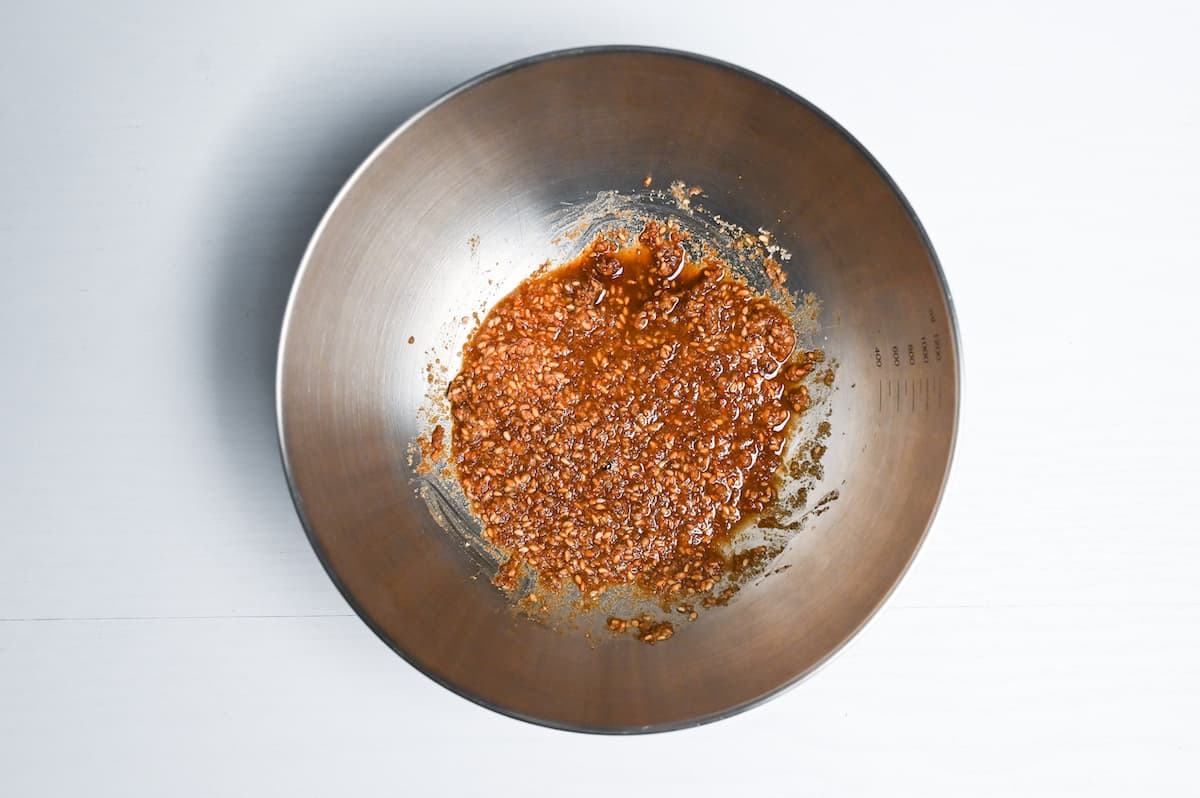
The great thing about this dressing is the flexibility. Want a stronger umami flavor? Add a small amount of white miso (and a little less salt). Want something rich? Use half of the sesame paste that has been ground up instead.
Just remember to balance the tastes in your meal. If you add other salty ingredients, make sure you add less soy sauce. If you want to make it sweeter, use more sugar or sweetener of choice.
i. Add the well-squeezed spinach to the bowl and toss until every leaf is glossy and evenly coated. Taste and adjust, add a splash of soy for savoriness or a pinch of sugar if your bunch skews bitter.
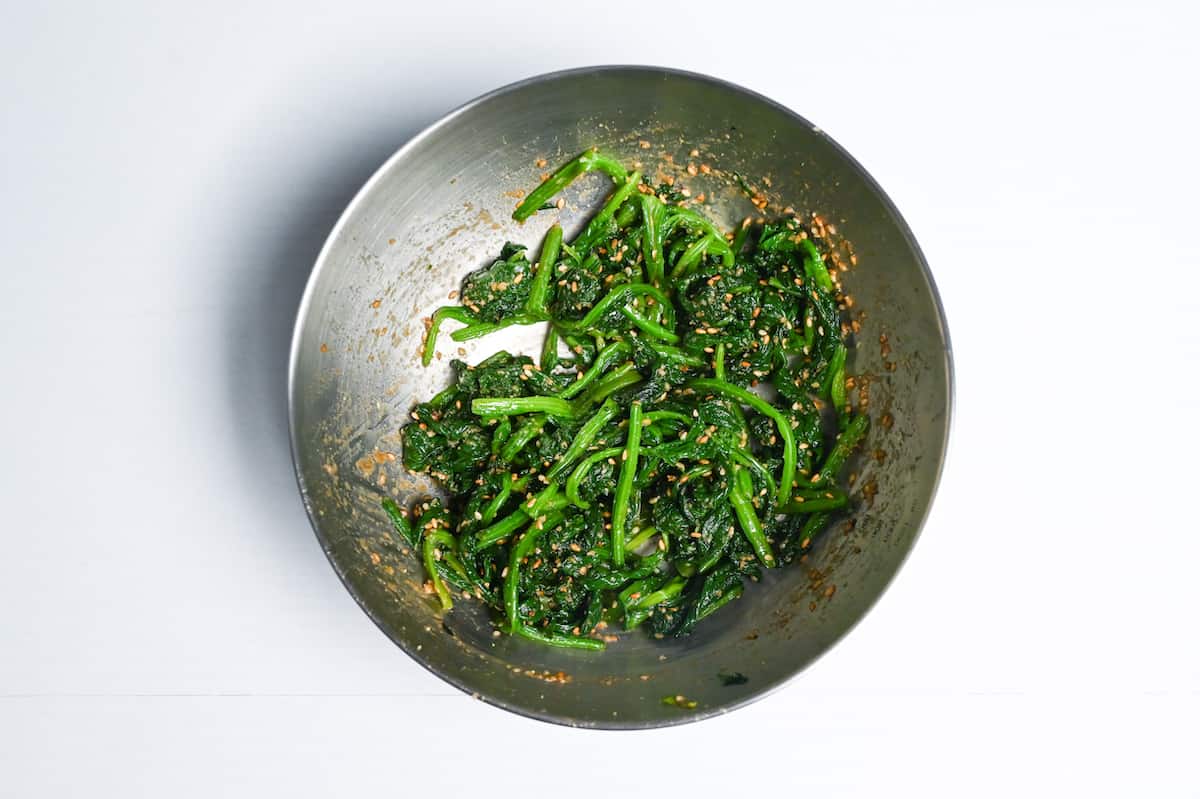
ii. Serve at room temperature or lightly chilled.
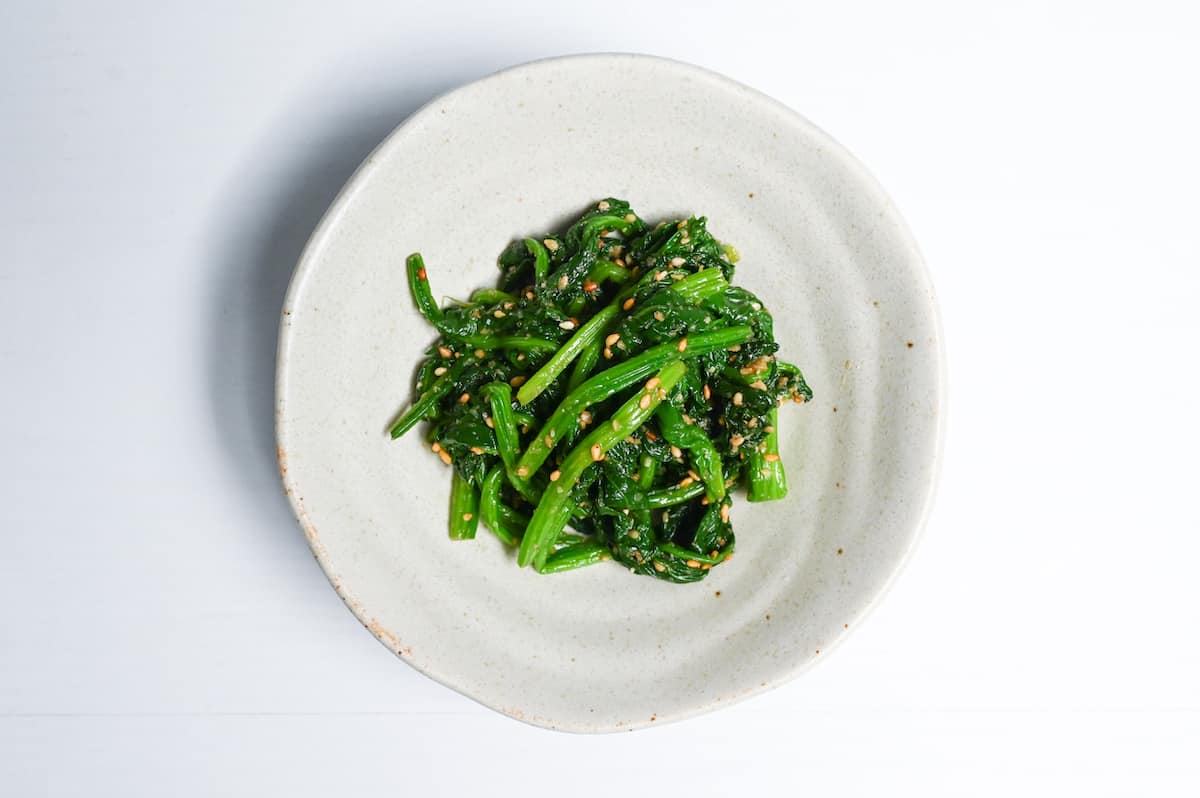

Essential Tips & Tricks
- Always rinse spinach thoroughly at the roots.
- Start blanching with stems for 30 seconds, then submerge leaves for only 15-30 seconds more. Overcooking makes greens dull and mushy.
- Shock the spinach immediately in ice water.
With these simple tips in mind, you’re set for success every time you make goma-ae salad.
Storage & Meal Prep
Fridge: Airtight container, 2-3 days maximum. Store in the coldest part of your refrigerator (not the door).
Freezer: Airtight container or freezer bags, up to 1 month. Wrap individual portions in plastic wrap, then place in freezer bags with air removed.
Meal Prep: Make a larger batch on weekends and portion into individual containers. The flavors actually improve after resting for a few hours, making this ideal for advance preparation.
Goma-ae is traditionally served chilled or at room temperature so it doesn’t need to be reheated.
What to Serve With This Recipe
- Grilled Mackerel (Saba Shioyaki)
- Teriyaki Salmon
- Agedashi Tofu
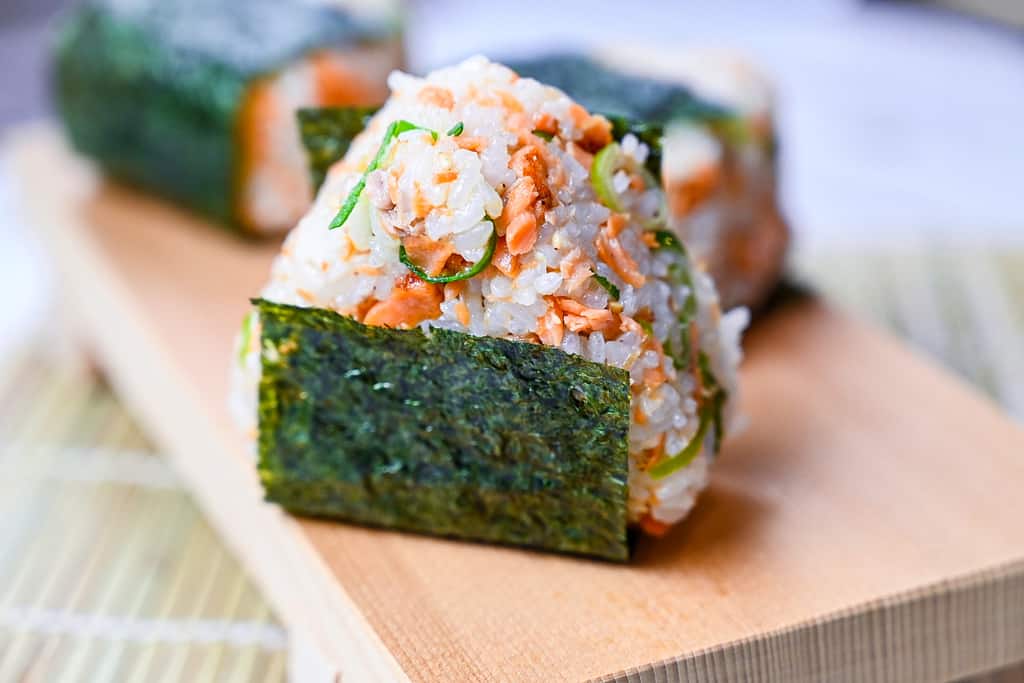
Spinach Goma-ae Q&A
Overcooking or covering the pot traps acids that dull the color. Always boil briefly in plenty of water without a lid, add salt, and plunge into ice water right away to keep it vibrant.
Portion into small containers right after cooking, then freeze and thaw only what you need. For smaller households, use half a bunch of spinach or freeze half immediately.
No, gomaae salad is meant to be enjoyed cold or room temperature. Reheating changes the flavor and texture.

More Japanese Salad Recipes
Ready to expand your repertoire? Browse through these easy Japanese salad recipes for quick and delicious side dishes!
Did You Try This Recipe?
I would love to hear your thoughts!
💬 Leave a review and ⭐️ rating in the comments below. 📷 I also love to see your photos – submit them here!
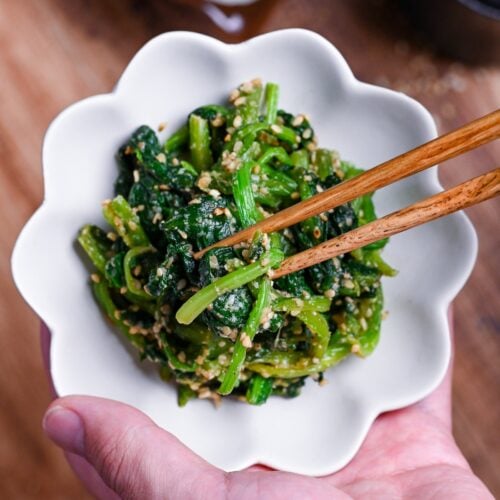
Goma-ae Salad (Japanese Spinach Salad with Sesame Sauce)
Ingredients
- 2000 ml water for blanching
- 1 tsp salt
- 250 g Oriental spinach
- 1 bowl ice cold water
Sesame sauce
- ¼ tsp salt
- ½ tbsp Japanese soy sauce (koikuchi shoyu)
- 2 tbsp ground sesame seeds
- 1 tbsp light brown sugar or granulated sugar
- ½ tbsp toasted white sesame seeds
- ½ tbsp dashi stock or water with a pinch of dashi granules, or water only
My recommended brands of ingredients and seasonings can be found in my Japanese pantry guide.
Can’t find certain Japanese ingredients? See my substitution guide here.
Instructions
- Start by filling a large pot with 2000 ml water and bring to a rolling boil. While you wait, fill a bowl with cold water and add 250 g Oriental spinach. Open the roots and swish vigorously to clean out sand and grit. Replace the water if it gets too sand and repeat until thoroughly cleaned.

- Once the water is boiling, add 1 tsp salt to the pot and mix. Bring to a boil once more and prepare 1 bowl ice cold water. When it's boiling rapidly, place the spinach in the pot root-first with the leaves above the surface of the water, leaning over the edge of the pot. Boil for 30 seconds.

- Push the leaves down to submerge them in the water and continue to blanch for 15-30 seconds (the stems 45-60 seconds in total).

- Remove the spinach from the water and transfer straight to the bowl of cold water to stop the cooking process.

- While the spinach cools, take a mixing bowl (big enough to add the spinach) and add ¼ tsp salt, ½ tbsp Japanese soy sauce (koikuchi shoyu), 2 tbsp ground sesame seeds, 1 tbsp light brown sugar, ½ tbsp toasted white sesame seeds, ½ tbsp dashi stock. (If you don't have dashi you can use an equal amount of water instead.) Mix well.

- Remove the spinach from the bowl and thoroughly squeeze out the excess water to avoid watering down the sauce. Cut off the roots, then cut it into thirds or quarters lengthways before adding it to the bowl of sauce. Mix until evenly coated and enjoy!

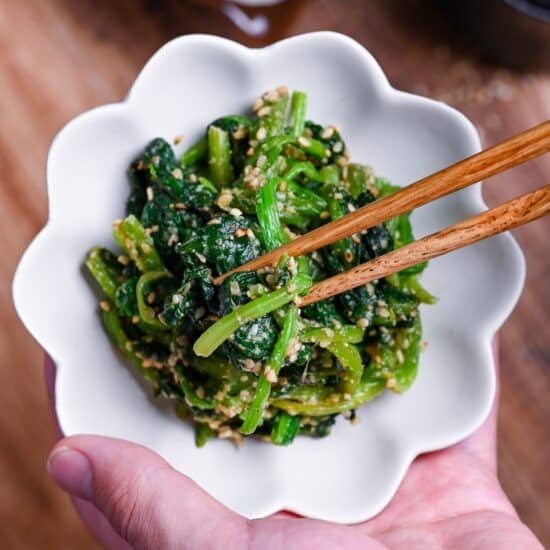




Leave a rating and a comment